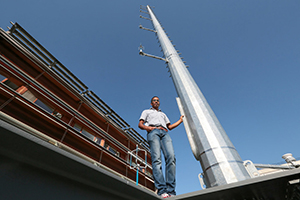
Contact: Dasaraden Mauree
The monitoring of high resolution vertical meteorological profiles is essential to determine the impact of urban areas / buildings on these variables. It is necessary to represent these effects when evaluating building energy use, air pollutant dispersion and renewable energy potential in urban planning scenarios.

MoTus is a 27m mast with instruments at a regular intervals (4m) along the vertical axis to obtain a high-resolution profile of meteorological parameters. The mast is located next to the LESO experimental building. It has been completed with 6 additional anemometers on the LESO-PB south façade to improve the understanding of turbulent processes and the automated control of blinds.
The geographical location of the monitoring tower allows measurement of meteorological variables. The EPFL campus can be seen as a complex and dense urban setup (typical of a number of European cities) and the courtyard next to the LESO building as a canyon covered partially by grass and asphalt. Besides the location of the campus itself, is very interesting because of the thermal inertia of the lake as well as the close proximity to the mountains.
Publications
On the Coherence in the Boundary Layer: Development of a Canopy Interface Model, in Frontiers in Earth Science, 2017.
Detailed Record – View with publisher
Multi-scale modelling to assess human comfort in urban canyons. Sustainable Built Environment (SBE) regional conference – Expanding boundaries, Zurich, Switzerland, 2016.
Detailed Record – Full Text – View with publisher
Energy Demand Analysis for Building Envelope Optimization for Hot Climate: A Case Study at AN Najah National University. PLEA 2016 – 36th International Conference on Passive and Low Energy Architecture, Los Angeles, USA, 2016.
Detailed Record
Energy demand and urban microclimate of old and new residential districts in a hot arid climate PLEA 2016 – 36th International Conference on Passive and Low Energy Architecture, Los Angeles, USA, 2016.
Detailed Record – Full Text
Evapotranspiration model to evaluate the cooling potential in urban areas – A case study in Switzerland, 14th International Conference of the International Building Performance Simulation Association, Hyderabad, 2015.
Detailed Record – Full Text
Multi-scale modelling to improve climate data for building energy models, 14th International Conference of the International Building Performance Simulation Association, Hyderabad, India, 2015.
Detailed Record – Full Text
Development of a new 1D urban canopy model: coherences between surface parameterizations, 9th International Conference on Urban Climate, Toulouse, France, 2015.
Detailed Record – Full Text
Evaluation of building energy use: from the urban to the building scale, 9th International Conference on Urban Climate, Toulouse, France, 2015.
Detailed Record – Full Text
Development of a multi-scale meteorological system to improve urban climate modeling, Université de Strasbourg, 2014.
Detailed Record – Full Text – View with publisher
Evaluating Error Propagation in Coupled Land-Atmosphere Models, in Earth Interactions, vol. 15, num. 28, p. 1-25, 2011.
Detailed Record – View with publisher